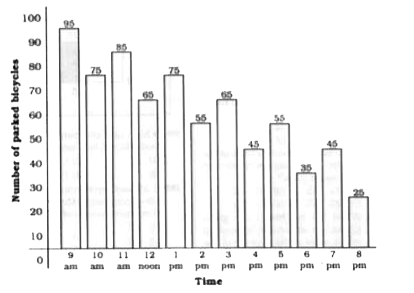Following are the car parking charges near a railway station up to Check if the parking charges are in direct proportion to the parking time.
To determine if the parking charges are in direct proportion to the parking time, we will analyze the given data step by step.
1. List the Parking Charges and Time:
- Up to 4 hours: ₹60
- Up to 8 hours: ₹100
- Up to 12 hours: ₹140
- Up to 24 hours: ₹180
2. Calculate the Charge per Hour for Each Time Period:
- For 4 hours:
Charge per hour=604=15
- For 8 hours:
Charge per hour=1008=12.5
- For 12 hours:
Charge per hour=14012≈11.67
- For 24 hours:
Charge per hour=18024=7.5
3. Compare the Charge per Hour Values:
- Charge per hour for 4 hours: 15
- Charge per hour for 8 hours: 12.5
- Charge per hour for 12 hours: 11.67
- Charge per hour for 24 hours: 7.5
4. Analyze the Results:
- The charge per hour decreases as the time increases.
- The values are not constant; they are decreasing.
5. Conclusion:
- Since the charge per hour is not constant, the parking charges are not in direct proportion to the parking time.
Final Answer:
No, the parking charges are not in direct proportion to the parking time because the proportions are not equal.
---
- Up to 4 hours: ₹60
- Up to 8 hours: ₹100
- Up to 12 hours: ₹140
- Up to 24 hours: ₹180
- For 4 hours:
Charge per hour=604=15
- For 8 hours:
Charge per hour=1008=12.5
- For 12 hours:
Charge per hour=14012≈11.67
- For 24 hours:
Charge per hour=18024=7.5
- Charge per hour for 4 hours: 15
- Charge per hour for 8 hours: 12.5
- Charge per hour for 12 hours: 11.67
- Charge per hour for 24 hours: 7.5
- The charge per hour decreases as the time increases.
- The values are not constant; they are decreasing.
- Since the charge per hour is not constant, the parking charges are not in direct proportion to the parking time.
No, the parking charges are not in direct proportion to the parking time because the proportions are not equal.
Topper's Solved these Questions
- BOOK - NCERTCHAPTER - DIRECT AND INVERSE PROPORTIONSEXERCISE - EXERCISE 13.211videos
DIRECT AND INVERSE PROPORTIONS
- BOOK - NCERTCHAPTER - DIRECT AND INVERSE PROPORTIONSEXERCISE - SOLVED EXAMPLES8videos
DIRECT AND INVERSE PROPORTIONS
- BOOK - NCERTCHAPTER - DATA HANDLINGEXERCISE - EXERCISE 5.15videos
DATA HANDLING
- BOOK - NCERTCHAPTER - EXPONENTS AND POWERSEXERCISE - SOLVED EXAMPLES9videos
EXPONENTS AND POWERS
Similar Questions
The car parking charges near is railway station upto 4hrs=60, 8hrs=100, 12 hrs=140, 24hrs=180. Check if the parking charges are in direct proportion to the parking time.
View SolutionThere are 14 lines in a car parking. There are 420 places for parking the cars in each line. How many cars can be parked in the car parking ?
View Solution
Knowledge Check
- Question 1 - Select One
Read the following information carefully and answer the given question:
'Pets are not allowed in the park premises' -A notice put up at the park entrance by the authority that is responsible for maintenance of the park.
Which of the following can be an assumption according to the given information? (An assumption is something that is supposed or taken for granted) (a) At least some people who visit the park have pets. (b) This is the only park which does not allow pets (c) People who ignored this notice were friend (d) There are more than one entrances to the parkAAt least some people who visit the park have pets.BThis is the only park which does not allow petsCPeople who ignored this notice were fmedDThere are more than one entrances to the park - Question 2 - Select One
Select the alternative that will improve the underlined part of the sentence in case there is no improvement select "no improvement".
The watchman prevent him from parking his car near thegate.Aprevents him for parkingBprevented him to parkCprevented him from parkingDNo improvement
Study the bar diagram and answer the following questions.
The bar diagram shows the number of bicycles parked in the parking space of a hall at various points of time.

The charges for parking is Rs. 1 per hour. What will be the total collection from 9 am to 7 pm?View SolutionStudy the bar diagram and answer the following questions.
The bar diagram shows the number of bicycles parked in the parking space of a hall at various points of time.

How many times, as mentioned in the graph, is the number of parked cycles above average ?View SolutionStudy the bar diagram and answer the following questions.
The bar diagram shows the number of bicycles parked in the parking space of a hall at various points of time.

What is the average number fo parked cycles as seen from the graph ?View SolutionA father with 6 children takes 3 at a time to a park without taking the same children. How often father goes to the park?
View SolutionStudy the bar diagram and answer the following questions.
The bar diagram shows the number of bicycles parked in the parking space of a hall at various points of time.

What is the percentage decrease in the number of parked cycles between 7 pm and 8 pm? (in whole number)View SolutionThe parking charges of a car in a private parking is Rs 20 for the first hour and Rs 10 for subsequent hours.Taking total parking charges to be y & total parking time as x hours form a linear equation.Write it in standard form.
View Solution

